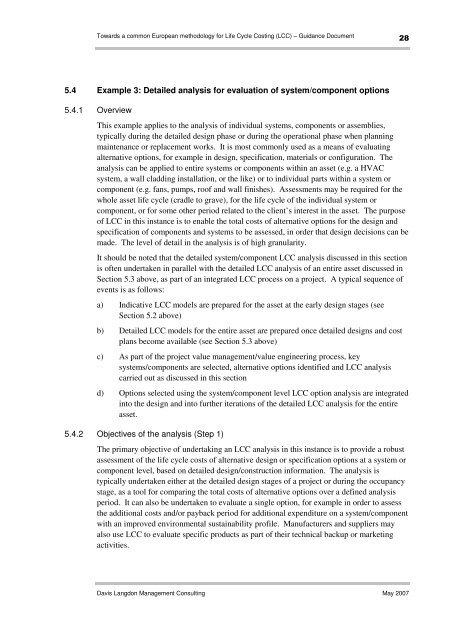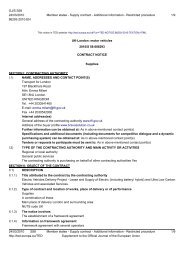Life cycle costing (LCC) as a contribution to sustainable construction ...
Life cycle costing (LCC) as a contribution to sustainable construction ...
Life cycle costing (LCC) as a contribution to sustainable construction ...
You also want an ePaper? Increase the reach of your titles
YUMPU automatically turns print PDFs into web optimized ePapers that Google loves.
Towards a common European methodology for <strong>Life</strong> Cycle Costing (<strong>LCC</strong>) – Guidance Document<br />
28<br />
5.4 Example 3: Detailed analysis for evaluation of system/component options<br />
5.4.1 Overview<br />
This example applies <strong>to</strong> the analysis of individual systems, components or <strong>as</strong>semblies,<br />
typically during the detailed design ph<strong>as</strong>e or during the operational ph<strong>as</strong>e when planning<br />
maintenance or replacement works. It is most commonly used <strong>as</strong> a means of evaluating<br />
alternative options, for example in design, specification, materials or configuration. The<br />
analysis can be applied <strong>to</strong> entire systems or components within an <strong>as</strong>set (e.g. a HVAC<br />
system, a wall cladding installation, or the like) or <strong>to</strong> individual parts within a system or<br />
component (e.g. fans, pumps, roof and wall finishes). Assessments may be required for the<br />
whole <strong>as</strong>set life <strong>cycle</strong> (cradle <strong>to</strong> grave), for the life <strong>cycle</strong> of the individual system or<br />
component, or for some other period related <strong>to</strong> the client’s interest in the <strong>as</strong>set. The purpose<br />
of <strong>LCC</strong> in this instance is <strong>to</strong> enable the <strong>to</strong>tal costs of alternative options for the design and<br />
specification of components and systems <strong>to</strong> be <strong>as</strong>sessed, in order that design decisions can be<br />
made. The level of detail in the analysis is of high granularity.<br />
It should be noted that the detailed system/component <strong>LCC</strong> analysis discussed in this section<br />
is often undertaken in parallel with the detailed <strong>LCC</strong> analysis of an entire <strong>as</strong>set discussed in<br />
Section 5.3 above, <strong>as</strong> part of an integrated <strong>LCC</strong> process on a project. A typical sequence of<br />
events is <strong>as</strong> follows:<br />
a) Indicative <strong>LCC</strong> models are prepared for the <strong>as</strong>set at the early design stages (see<br />
Section 5.2 above)<br />
b) Detailed <strong>LCC</strong> models for the entire <strong>as</strong>set are prepared once detailed designs and cost<br />
plans become available (see Section 5.3 above)<br />
c) As part of the project value management/value engineering process, key<br />
systems/components are selected, alternative options identified and <strong>LCC</strong> analysis<br />
carried out <strong>as</strong> discussed in this section<br />
d) Options selected using the system/component level <strong>LCC</strong> option analysis are integrated<br />
in<strong>to</strong> the design and in<strong>to</strong> further iterations of the detailed <strong>LCC</strong> analysis for the entire<br />
<strong>as</strong>set.<br />
5.4.2 Objectives of the analysis (Step 1)<br />
The primary objective of undertaking an <strong>LCC</strong> analysis in this instance is <strong>to</strong> provide a robust<br />
<strong>as</strong>sessment of the life <strong>cycle</strong> costs of alternative design or specification options at a system or<br />
component level, b<strong>as</strong>ed on detailed design/<strong>construction</strong> information. The analysis is<br />
typically undertaken either at the detailed design stages of a project or during the occupancy<br />
stage, <strong>as</strong> a <strong>to</strong>ol for comparing the <strong>to</strong>tal costs of alternative options over a defined analysis<br />
period. It can also be undertaken <strong>to</strong> evaluate a single option, for example in order <strong>to</strong> <strong>as</strong>sess<br />
the additional costs and/or payback period for additional expenditure on a system/component<br />
with an improved environmental sustainability profile. Manufacturers and suppliers may<br />
also use <strong>LCC</strong> <strong>to</strong> evaluate specific products <strong>as</strong> part of their technical backup or marketing<br />
activities.<br />
Davis Langdon Management Consulting May 2007







